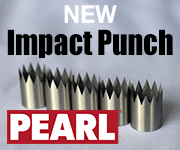Featured Stories
-
-
Elevating Pouch Manufacturing with Pearl Technologies' Cutting-Edge Solutions
For manufacturers seeking efficiency, precision, and safety in pouch production, Pearl delivers unmatched innovation across three standout... -
Faster Product Composition Analysis Equals Better Quality Assurance
Near Instant Testing and Reduced Costs to be Found
News | New Products
-
PACKZ 11 Launches with Industry-First RIP Integration
Plus extended CF2 format and automated support for 2-D Barcodes as Required by the Sunrise 2027 Initiative
-
Double E Group Acquires CAC, Further Enhancing its Strength in the Global Converting Industry
Double E Group, a global leader in converting components and web handling technology, has announced its acquisition of Converter Accessory Corporation (CAC)
-
Nobelus Launches Entry-Level Komfi® Thermal Laminator
FINISHING SOLUTIONS SUPPLIER OFFERS NEW JUNIOR 52 LAMINATING SYSTEM
-
Double E Group Mourns the Loss of Founder and Converting Industry Pioneer, Richard Edward Flagg
Double E Group announces with profound sadness the passing of its founder, Richard Edward “Ed” Flagg, on June 23, 2025. He was 85.
-
Convertech Brand to Fully Transition to Double E Group Same Team, Same Excellence, Unified Name
Double E Group has announced that Convertech, one of its subsidiaries and a trusted provider of core chucks and shaft solutions for the converting industry, will now operate solely under the Double E Group brand.
-
Pulse is Making Print Simple at Labelexpo Europe 2025
Narrow web ink specialist Pulse is Making Print Simple at Labelexpo Europe 2025, as it challenges flexo printers to rethink how they work and shows solutions that turn production bottlenecks into revenue generators.
-
ROTOCON to debut at Labelexpo Europe with three machine demonstrations
ROTOCON will make its Labelexpo Europe debut, exhibiting together with HS Machinery on stand 4D21.
Expert Advice
The Long & the Short of Web Bending
- Published: September 01, 2003, By Timothy J. Walker, TJWalker & Assoc. Inc.
Last month I reviewed the parallel entry principle (PEP), how a web wants to “go with the flow” of a roller's surface. This month I want to expand your understanding of the parallel entry principle, explaining where the force to bend the web comes from and how to use this knowledge to your advantage.
With parallel, cylindrical rollers, the PEP keeps your web on machine centerline. But our webs don't always stay in their lanes, and sometimes we don't want them to. Unwinding and misaligned rollers will put the web in the wrong lane, and we have to bring it back.
When we use web spreading rollers and steering guides, we are trying to bend the web off or on course. Bending a web is harder than you think. This can be a good thing if we don't want lateral bending, but it's a bad thing if we are depending on it to steer, bend, or spread your web.
If the surface directions of sequential rollers are aligned, the path from exiting one roller and entering another roller does not require web bending. However, if their directions are misaligned, the web will try to bend in order to “go with the flow” of both rollers. Bending a web, like bending any solid material, requires force. In web handling, this force is provided by the web-to-roller traction.
Cantilever beam bending models work well to predict small web deflections. A cantilevered beam model assumes a perpendicular angle and position of the fixed side and a “to be determined” angle and position on the free end. As a force is applied normal to the tip of the cantilever beam, it will deflect away from the load. The angle at the free end will change as the beam deflects.
How much force is required to bend a beam by 0.1 in? It will depend on the beam dimensions (thickness, width, and length) and the modulus of elasticity. The deflection for a given load will be directly proportional to modulus. The modulus of aluminum is 20x higher than polyester film (10,000 kpsi vs. 500 kpsi); therefore, bending aluminum will require 20x more force. The bending of a long span or beam is proportional to the inverse of length cubed; so, doubling a length will reduce the load to bend it by 8x.
In following the parallel entry principle, the web bends across its width, so the resistance will be proportional to web thickness but increase with width cubed. Doubling the web's width makes it 8x more resistant to lateral bending.
Let's run through a few examples. How much force is required to redirect a 60-in.-wide, 0.003-in.-thick, 60-in.-long span of polyester web by 0.1 in? What do you think the answer is? Do you have an intuitive feel for this? Beam theory estimates this will require almost 40 lb of lateral force. Every additional 0.1 in. of lateral bending will require another 40 lb.
If we are using the parallel entry principle to guide the web (the mechanism used in steering guides), what is the maximum lateral bending we could induce with a roller of 90-deg wrap (1.57 radians), coefficient of friction of 0.25, and 2 PLI of tension over a 60-in. width? Do you have an intuitive feel for this question? The frictional force on this roller will be 47 lb of friction. An available force of 47 lb can bend the 60-in. web span ⅛ in. — not much, which is why steering guides need long entry spans.
If we recalculate bending with an increased entry span to 120 in., each 0.1 in. of lateral bending will require only 5 lb, and we will be able to bend the web almost 1 in. If we keep increasing the span, to a length-to-width ratio of 3, or a 180-in. entry span, we can bend the web ±3 in.
This strong relationship of bending force as a function of length-to-width ratio is an important corollary to the parallel entry principle. If you want the web to bend, as when we use steering guides — go long. If you don't want bending (and tracking error), such as when we want good slit-to-wind tracking or to prevent tracking-related wrinkles — go short.
Next month: More on PEP and web spreading rollers.
Timothy J. Walker has 20+ years of experience in web handling processes. He specializes in web handling education, process development, and production problem solving Contact him at 404/373-3771; tjwalker@tjwa.com; tjwa.com.


















